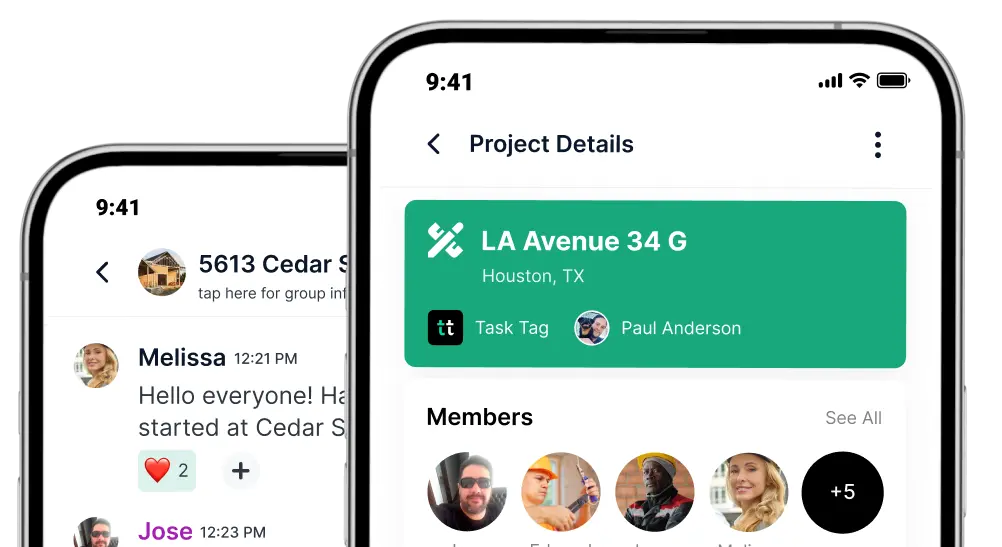Mastering Construction Project Management
In this blog, we will take you on a fascinating journey through the world of construction project management. You will discover the importance of construction project management and the challenges in it. We'll unravel the entire lifecycle of a project, from the initial spark of an idea to the triumphant completion. Dive into the intricacies of planning, scheduling, budgeting, and risk management, and learn how to keep your project on track and under budget. We will also explore how cutting-edge technology, sustainability practices, and innovative tools are revolutionizing the construction industry. Get ready to be inspired and equipped with practical tips to elevate your construction projects to new heights!

What Is Construction Project Management?
Let's dive into the world of construction project management. Imagine you're directing a play, ensuring every scene runs smoothly from rehearsal to the final curtain call. Construction project management is similar, but you're managing a building project instead.
It involves planning, directing, and organizing every aspect of the project, from the initial idea to the finished structure, ensuring it's completed on time and within budget. Think of it as assembling a giant puzzle where costs, schedules, materials, and risks must fit together perfectly.
A construction project manager is like an orchestra conductor, coordinating with architects, owners, and contractors to keep everyone on the same page and ensure the project progresses smoothly.
The Role of a Construction Project Manager

What are the key responsibilities of a project manager in construction?
- Planning: They create detailed plans to organize each step of the project.
- Hire, Fire, and Supervise: They hire the right team, let go of underperformers, and supervise everyone.
- Set Goals: They set clear, achievable goals to guide the project.
- Deliver on Time: They ensure the project stays on schedule.
- Stay on Budget: They manage the budget to prevent overspending.
- Keep Client and Boss in the Loop: They regularly update the client and boss on progress.
- The Dispute Manager: They resolve conflicts and disputes fairly.
- Draft Contracts: They create clear, legally binding agreements with contractors and suppliers.
- Manage Risks: They identify potential problems and plan solutions in advance.
Reference for detailed key responsibilities of construction project manager
Skills required to become a construction project manager
- Technical Communications: You’ll be the go-to person, chatting daily with contractors, staff, and upper management. Strong verbal, written, and presentation skills are your superpowers to ensure smooth communication and avoid misunderstandings.
- Building Code Knowledge: Know your building rules! Zoning laws, fire protection, and structural standards are your responsibility. Keep the building safe and up to code, making adjustments as needed.
- Construction Estimating: Become a master estimator! Accurately forecast materials and costs to keep the project profitable and supplies plentiful, ensuring the work never stops.
- Project Control and Scheduling: Plan like a pro. Control costs, schedule resources, and manage changes. Keep accurate records and impress upper management with your detailed project updates.
- Team Management: Juggle multiple teams with ease. Upper management, hired staff, contractors – they all need your coordination. Foster a positive environment where everyone works together efficiently.
- Leadership Skills: Inspire and motivate! Leadership is about influencing your team to work towards a common goal. Great project managers lead with positivity and drive, making leadership the ultimate skill.
Reference for skills of construction project manager
Qualification required to become a construction project manager
To become a construction project manager, having a solid educational background is important.
- Bachelor’s degree in Engineering, Architecture, Project Management, Construction Management, Civil Engineering, or a related field (preferred) or 4-year BA/BS in a relevant major (construction management, engineering, etc).
- Proficiency in CAD software (e.g., Sketchup, AutoCAD, SolidWorks, Revit) or equivalent design tools.
- Experience is key too. You should have some experience in managing projects, especially those related to engineering or design. This means you’ve worked on big projects from the very beginning all the way to the end. If you have experience with estimating costs or managing projects, that’s a big plus.
Project Life Cycle in Construction
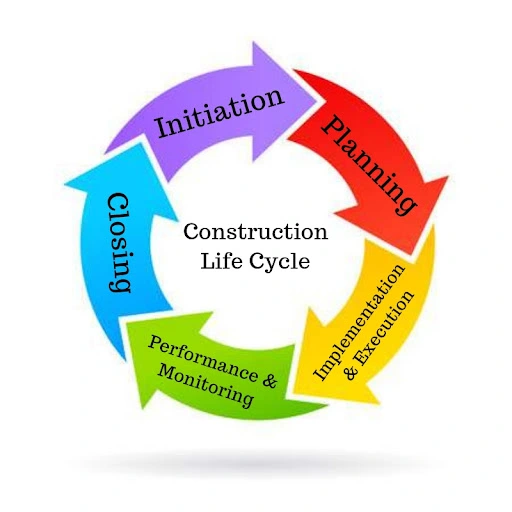
When we talk about the construction project lifecycle, there are five key phases to navigate:
- Project Initiation and Conception: The journey begins with an idea. This phase involves assembling a dedicated team and diving into the details immediately. A feasibility test helps determine if the project is realistic and worth pursuing.
- Project Planning and Definition: Once feasible, we move to planning. This is where we define the project, set timelines, and outline the budget. A solid plan is crucial as it lays the foundation for the entire project.
- Project Execution and Launch: Now comes the exciting part – execution! This is where all our planning comes to life. Regular progress reports keep us on track, ensuring everyone is aligned and any issues are addressed promptly.
- Project Performance: With the project underway, we monitor performance to ensure it stays on schedule and within budget. Daily supervision and adjustments keep everything on course.
- Project Close: Finally, we reach the project close. Here, we finalize all aspects and present the completed project to the client. Their approval marks the successful conclusion of our efforts.
Reference of detailed Project Lifecycle
Key Phases of Construction Project
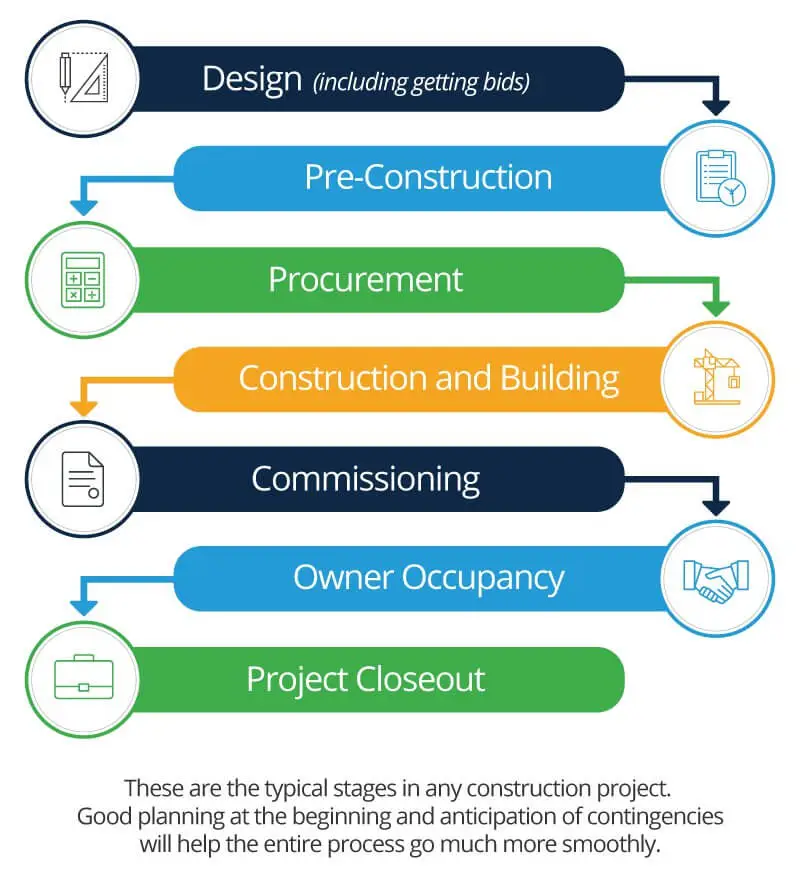
When we talk about the construction process, it’s divided into five main phases:
1. Pre-Design (Project Initiation)
First up is the pre-design phase, also known as the initiation phase. Here, we evaluate the project's requirements and feasibility, setting a solid foundation.
Key Activities in Pre-Design Phase
Feasibility Study: Assess the project's merits, costs, design, location, and schedule.
Project Initiation Document (PID): Define the project scope, milestones, and success criteria.
Construction Documents: Identify team members and their roles.
Challenges in Pre-Design Phase
Highlighting difficult-to-achieve objectives.
Drafting precise contractual documents to avoid liability.
Ensuring clear communication on budgets and goals.
2. Design (Pre-Construction)
Next is the design phase, where comprehensive plans are drawn up, and preparation for construction begins.
Key Activities in Design Phase
Choosing Contractors: Select based on design-bid-build contracts.
Establishing Chain of Command: Define team structure and responsibilities.
Cost Estimation: Finalize the budget.
Risk Assessment: Plan for potential issues.
Documentation: Obtain permits, conduct tests, and ensure safety plans.
Challenges in Design Phase
Communication breakdowns from design changes.
Legal examination of conflicts of interest.
Environmental concerns delaying the project.
3. Procurement
In the procurement phase, we source, purchase, and transport materials, equipment, and services.
Key Activities in Procurement
Sourcing Materials: Purchase materials and coordinate team members.
Building the Team: Hire necessary contractors and subcontractors.
Challenges in Procurement
Deciding between local and global material sourcing.
Market volatility affecting resources.
Clear contractual agreements and payment terms.
4. Construction and Monitoring
This is where physical construction begins, and daily tasks are performed by contractors.
Key Activities in Construction and Monitoring
Building the Structure: Ensure teams follow the project plan and coordinate schedules.
Maintaining Documentation: Track progress and quality.
Challenges in Construction and Monitoring
Coordinating schedules to avoid delays.
Maintaining onsite safety protocols.
Addressing any unexpected structural issues.
5. Post-Construction (Closeout)
The final phase involves wrapping up the project and handing it over to the client.
Key Activities in Post-Construction Phase
Reviewing with Client: Create a punch list for any needed improvements.
Finalizing Documents: Complete all project closeout documents.
Transferring Ownership: Deliver documentation to the client.
Challenges in Post-Construction Phase
Addressing punch list items and client feedback.
Handling potential legal disputes.
Finalizing all documentation efficiently.
Reference for phases in construction project
Planning and Scheduling in construction projects
Project Scheduling Tools
1. Gantt Chart
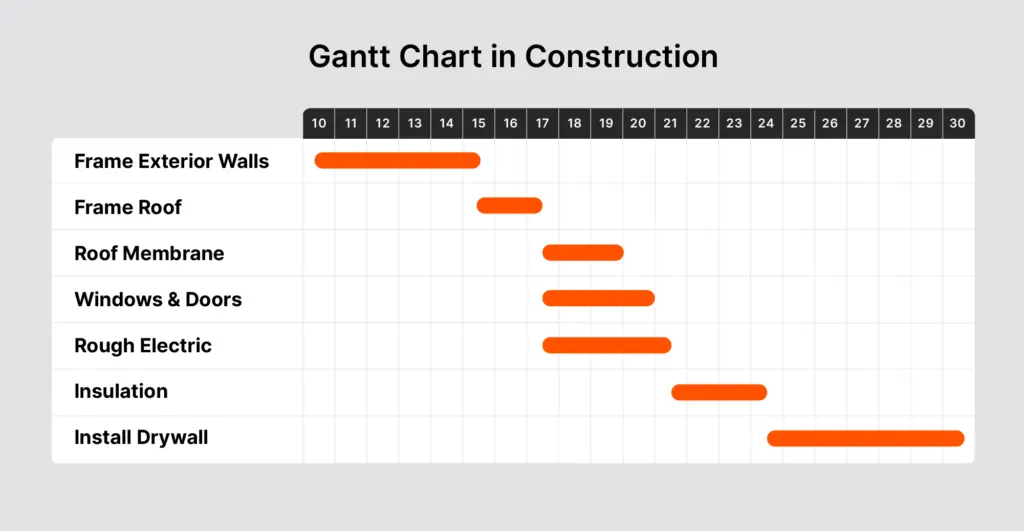
A Gantt chart is a widely-used tool in project management for visually representing tasks and their timelines. On the left side, you’ll find a list of tasks, while the top showcases a timeline. Each task is depicted by a bar, with its position and length indicating the start date, duration, and end date. This format provides a clear overview of:
- The tasks involved in the project
- The start and end dates for each task
- The duration each task will take
- Any overlap between tasks and the extent of these overlaps
- The overall timeline of the project
In essence, a Gantt chart helps you quickly understand what needs to be done and when it needs to be done.
Guide for using Gantt Chart in Construction Project Management
2. Critical Path Method (CPM)
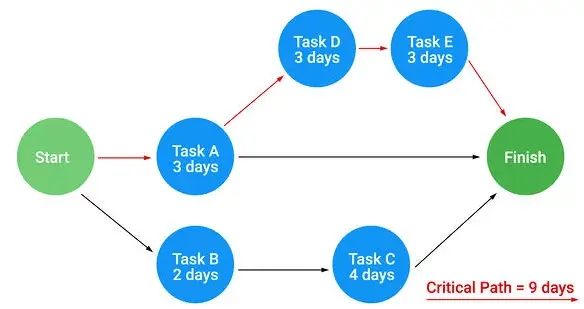
The Critical Path Method (CPM), also known as Critical Path Analysis (CPA), is a project management technique used to identify essential tasks and determine scheduling flexibilities. The critical path is the longest sequence of tasks that must be completed on time for the entire project to finish on schedule. Any delay in these tasks will delay the whole project.
CPM involves pinpointing key tasks, understanding task dependencies, and calculating task durations. Developed in the late 1950s to address scheduling inefficiencies and rising costs, CPM has since become a vital tool for planning and prioritizing project tasks. It helps break down complex projects into manageable tasks and provides a clearer view of project flexibility.
Why Use Critical Path Analysis?
CPA offers valuable insights for planning projects, allocating resources, and managing schedules. Here’s why it’s beneficial:
Improves Future Planning: CPM compares expectations with actual progress, using data from current projects to inform future plans.
Facilitates Effective Resource Management: It helps prioritize tasks and avoid resource constraints.
Avoids Bottlenecks: By plotting project dependencies, CPM helps identify which activities can run in parallel, preventing delays.
Reference - How to use CPM for Project Management
3. The Project Evaluation Review Technique (PERT)
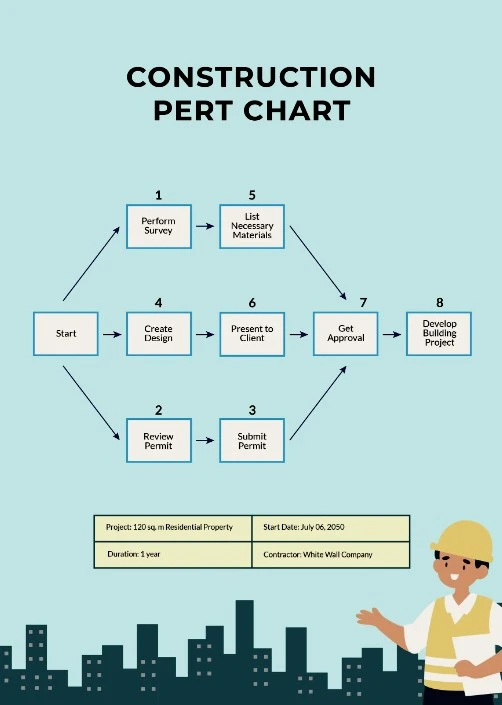
It is a project management tool designed to estimate the time needed to complete tasks and ensure efficient scheduling and coordination. Developed by the US Navy in the 1950s, PERT helps manage complex projects by breaking them down into individual tasks, estimating durations, and identifying the critical path—the longest sequence of tasks that determines the project's overall timeline. PERT charts use nodes to represent milestones and arrows to depict tasks, helping project managers visualize dependencies and potential delays.
This method incorporates four time estimates: optimistic, pessimistic, most likely, and expected, to provide a realistic timeframe for task completion. PERT maximizes resource use, aids in planning without prior data, and improves timeline accuracy. However, it can be complex, especially for large projects, and requires frequent updates and subjective time analysis, which may introduce bias.
Detailed Guide of Project Evaluation Review Technique
Resource Allocation in Construction
Materials Management: In construction, it’s crucial to have the right materials at the right time. This means predicting what you’ll need, scheduling deliveries, and keeping track of inventory to avoid shortages or excesses. Good relationships with suppliers can help manage unexpected changes.
Labor Management: Efficiently managing workers is key to staying on schedule. This involves assigning tasks based on skills and availability, scheduling shifts, and keeping labor costs under control. Tools like workforce management software can help track productivity and make adjustments as needed.
Equipment Management: You need various equipment for construction projects. Managing equipment means scheduling its use to prevent conflicts, maintaining it to avoid breakdowns, and deciding whether to rent or buy. Ensuring machinery is available and in good condition is vital.
Time Management in Construction
Scheduling: Creating a detailed project schedule is essential. Tools like Gantt charts, CPM, and PERT help visualize timelines, identify critical tasks, and understand task dependencies. A good schedule sets realistic deadlines and expectations.
Monitoring Progress: Regularly check progress against the schedule. This includes site inspections, meetings, and using project management software to track tasks. Early detection of delays allows for quick fixes.
Adjusting Plans: Be flexible. Even with good planning, unexpected events can occur. Adjust the schedule as needed—reallocate resources, work overtime, or resequence tasks to stay on track.
Communication: Keep clear communication with everyone involved—project managers, contractors, suppliers, and clients. Regular updates and transparency help manage the schedule and address delays efficiently.
Construction Budgeting and Cost Management
1. What is Construction Budgeting?
Construction budgeting is estimating and allocating financial resources for a project. It includes forecasting costs for labor, materials, equipment, and permits to ensure the project stays within budget.
2. Importance of Understanding the Project
Understanding the project scope, goals, and potential risks helps create an accurate budget and ensures alignment with the project owner's expectations.
3. Why Budgeting is Important
Budgeting helps plan and manage costs, control expenses, and secure financing. It provides a baseline for tracking project expenses and managing cash flow.
4. Components of a Construction Budget
- Direct Costs: Construction materials, labor, equipment.
- Indirect Costs: Permits, consultant fees, overhead costs.
- Contingency Budgets: Funds set aside for unexpected costs, such as scope changes, unforeseen conditions, and delays.
5. Importance of Budget Monitoring
Monitoring the budget helps identify potential cost overruns, control costs, and keep the project within the allocated budget.
6. Ways to Monitor Budget Properly
- Set up a budget monitoring system.
- Regularly review expenses.
- Accurately estimate costs.
- Track actual vs. budgeted costs.
- Identify and address deviations.
- Maintain a contingency budget.
7. Tools and Software
Utilize construction budgeting software, project management tools, and financial management tools to create detailed cost estimates, track expenses, and manage cash flow effectively.
8. Best Practices
- Establish clear budget goals.
- Monitor expenses closely.
- Use technology to manage budgets.
- Implement cost control measures.
- Communicate openly with stakeholders.
- Plan for unexpected costs with a contingency budget.
Essential Tips for Effective Construction Budget Management
Risk Management in construction projects
Identifying Risks
To manage risks effectively in construction, start by identifying potential risks. Use methods like brainstorming, expert interviews, and historical data analysis to uncover anything that might go wrong, such as delays, cost overruns, or safety issues.
Risk Analysis
Once risks are identified, evaluate their likelihood and potential impact. This helps prioritize which risks need immediate attention. Use tools like risk matrices to assess and visualize the significance of each risk.
Risk Mitigation
Develop strategies to manage and mitigate risks. This could include contingency planning, allocating extra resources, or adopting alternative construction methods. The goal is to minimize the impact of risks on the project.
Construction Quality Management
Quality Planning
Set clear quality objectives and standards at the beginning of the project. Define what quality looks like for each aspect of the project, from materials to workmanship, ensuring everyone knows the benchmarks.
Quality Assurance
Implement processes to ensure these quality standards are met. This involves regular inspections, audits, and compliance checks throughout the project lifecycle. It's about building quality into the process rather than inspecting it in at the end.
Quality Control
Monitor specific project outcomes to ensure they comply with the set quality standards. Use tests and inspections to verify that the work meets the required specifications and address any deviations promptly.
Construction Safety Management
Safety Protocols
Safety is paramount in construction. Establish and follow strict safety protocols and regulations to protect all team members. This includes wearing protective gear, adhering to safety procedures, and ensuring equipment is used correctly.
Training and Awareness
Ensure everyone on the project is trained and aware of safety practices. Regular training sessions and safety briefings keep safety top-of-mind and help prevent accidents.
Incident Response
Have clear procedures for responding to accidents and emergencies. This includes knowing first aid, emergency contacts, and having a plan for evacuations or immediate actions if an incident occurs. Prompt and effective response can mitigate the severity of accidents.
Construction Communication
What is Construction Communication?
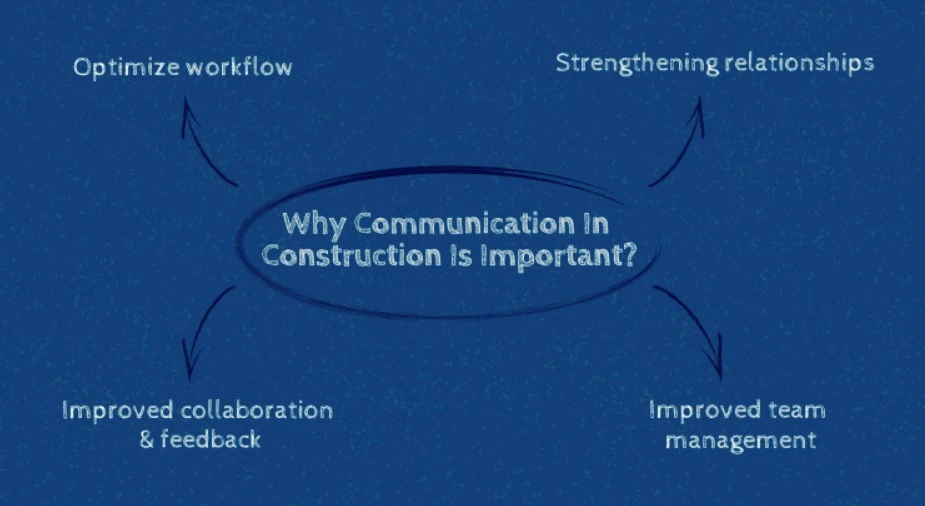
Construction communication ensures effective interaction and collaboration among all stakeholders in a project, including architects, engineers, contractors, subcontractors, suppliers, and clients. It is essential for completing projects on time and within budget.

Optimizing Workflow: Clear communication helps coordinate efforts, manage supply chains, and resolve challenges, keeping the project on schedule and within budget.
Strengthening Relationships: Good communication builds trust and transparency among stakeholders.
Improved Team Management: Effective communication clarifies roles, facilitates proactive management, and enhances team confidence and problem-solving.
Enhanced Collaboration and Feedback: Open communication promotes idea sharing, innovation, and feedback, leading to better project outcomes.
Challenges of Poor Communication
Onsite Confusion: Miscommunication leads to mistakes, delays, and cost overruns.
Project Delays: Unclear messages and delayed information flow cause setbacks.
Overspending: Errors from miscommunication result in unnecessary expenses and budget overruns.
Safety Risks: Poor safety communication can lead to job site injuries and hazards.
Developing a Communication Plan
Create Clear Channels: Establish protocols early and ensure everyone is aware of them.
Invest in Technology: Use collaboration software for effective document management.
Encourage Open Communication: Foster an environment where team members can voice concerns and share ideas.
Hold Regular Meetings: Regularly review project status and align on goals.
Document Everything: Keep detailed records to avoid misunderstandings.
Use a Single Data Source: Maintain accurate records on a unified platform.
Tips for Effective Communication
- Establish a clear communication chain of command.
- Select the right communication channel for each message.
- Be an active listener.
- Avoid confusion by using clear, jargon-free language.
- Stick to the facts and share professional opinions when necessary.
By following these principles, you can ensure smooth and effective communication in construction projects, leading to successful and timely project completion.
Discover the Importance of Communication in Construction
Construction Procurement Management
What is Construction Procurement?
Construction procurement involves securing products and services needed to complete a project on time and within budget. Key responsibilities include defining project requirements, soliciting bids, purchasing supplies, monitoring contracts, and resolving issues.
Benefits of Procurement
Effective procurement ensures high-quality materials and services are available when needed, keeping projects under budget and ahead of schedule. A well-managed procurement process enhances project management and prevents costly mistakes.
Role of Procurement Managers
Procurement managers handle logistics, bidding, purchases, schedules, and budgets. They create strategic plans, evaluate contracts, manage resources, and adapt to changes in project scope or schedules.
Types of Procurement
Design-Bid-Build: Owner designs, bids out, and contractor builds under a flat fee.
Design and Build: Contractor designs and builds for a fixed price.
Management Contract: Multiple contractors managed by a lead contractor for a fee.
Construction Management: Owner appoints a team to oversee procurement.
Private Finance: Contractor designs, builds, and leases to the client.
Emerging Ideas: Progressive Design-Build, public-private partnerships, and Integrated Project Delivery.
Detailed Construction Procurement Process
Technological Integration in Construction Project Management
BIM (Building Information Modeling)
Building Information Modeling (BIM) is a digital representation of the physical and functional characteristics of a building. Used for designing, constructing, and managing buildings and infrastructure, BIM provides a comprehensive digital model of a building, including its components and systems. As a result of comprehensive capabilities, BIM is becoming increasingly popular in the construction industry.
Increased Collaboration and Coordination
With BIM software, everyone from architects to contractors can collaborate in real-time. This shared digital workspace ensures everyone accesses the same information, eliminating communication errors and delays. The result? A more coordinated and efficient construction process.
Reduced Construction Time and Cost
BIM allows contractors to simulate construction and catch potential issues before starting. This leads to more accurate cost estimates and fewer costly errors. Off-site fabrication of components also speeds up on-site construction, saving both time and money.
Improved Quality and Safety
Detailed visualizations and simulations in BIM help identify safety hazards, reducing accident risks. The software ensures precise planning and coordination, resulting in higher quality outcomes. It’s also great for quality control, ensuring all systems meet standards.
Enhanced Sustainability
BIM helps evaluate the environmental impact of building components, aiding in reducing energy consumption and waste. It supports life cycle assessments, considering the environmental impact throughout a building's lifespan, promoting sustainability.
Improved Facility Management
After construction, BIM remains invaluable for facility management. It provides digital records for maintenance planning and asset management, and helps evaluate system performance for efficient operation.
In essence, BIM boosts collaboration, reduces costs, improves quality and safety, enhances sustainability, and streamlines facility management, making it an indispensable tool in modern construction.
Project Management Softwares
Everyone has a different way of managing projects. Some people like to use their inbox to keep track of tasks. Others prefer to visualize work on a Kanban board or in a calendar view, while some even prefer the old pen and paper system. That's fine on an individual level, but when you collaborate on projects as a team, you need a flexible and capable project management tool that works for everyone. And with so many teams still working remotely, there's an even more pressing need for a task management app that can help track projects, collaborate, and keep everyone in the loop.
Free project management software can give you the flexibility you need to manage tasks, communicate with stakeholders, and maintain project visibility—without paying a cent.
The 9 best free project management tools
- TaskTag for construction Project Management
- Trello for visually managing projects
- Asana for teams
- ClickUp for customized task views
- Wrike for spreadsheet-like features
- ActiveCollab for freelancers and small agency teams
- Airtable for building a customized project management app
- Jira for developers
- Height for AI features
Emerging Technologies in Project Management
AI in Project Management (PM)
Managing construction projects is a complex task involving planning, resource coordination, and cost control. This is where artificial intelligence (AI) shines:
Efficient Planning: Creating an accurate plan is vital for the success of a construction project. AI helps project management teams by evaluating factors like resource availability, estimated time for each stage, and potential obstacles, leading to more robust and realistic plans.
Error Reduction: AI's ability to identify potential issues before they escalate is invaluable. By analyzing real-time data, AI can alert project managers to deviations or risks, enabling quick and efficient responses.
Resource Optimization: AI optimizes resource allocation by determining the right amount of labor, materials, and machinery needed at each project stage. This reduces waste and unnecessary costs.
Real-Time Monitoring: AI enables real-time tracking of project progress. Sensors and monitoring systems collect valuable data to help keep the project on track and support informed decision-making.
IoT in Construction: A Game Changer
What is IoT?
IoT is the interconnection of devices that collect and exchange data over the internet. These devices are embedded with sensors and software that enable them to communicate with each other and with other systems. IoT devices can be used in a variety of industries, including healthcare, agriculture, and transportation, to name a few. In the construction industry, IoT is used to manage job sites and equipment, monitor safety, and improve project management.
Video Reference - What is IoT in Construction?
How IoT is Revolutionizing Construction
Sensor Technology: IoT sensors monitor parameters like temperature, humidity, and pressure. This helps construction managers spot potential issues early. For example, sensors can ensure concrete cures properly and monitor a building's structural integrity to keep it safe and secure.
Drone Usage: Drones survey job sites, track progress, and identify safety hazards. They can inspect hard-to-reach areas and transport materials, reducing the need for manual labor and improving efficiency.
Video Reference - IoT Revolutionizing Construction
Benefits of IoT in Construction
Improved Safety: IoT identifies hazards before they become accidents, enhancing safety.
Increased Efficiency: Automates tasks, reduces manual labor, and optimizes resource use.
Real-Time Monitoring: Provides real-time data on progress, helping make informed decisions and avoid delays.
Lower Costs: Tracks material usage, reduces waste, and manages resources effectively.
Better Quality Control: Ensures materials and processes meet standards, preventing defects.
Challenges and Limitations
High Implementation Costs: Initial setup can be expensive.
Dependency on Internet: Requires reliable connectivity, which can be problematic in remote areas.
Security Concerns: Vulnerable to cyber-attacks and data breaches.
Compatibility Issues: Different IoT systems may not work well together.
Technical Expertise: Lack of know-how can hinder adoption.
Overcoming Challenges
Address Resistance to Change: Educate and demonstrate the benefits to encourage adoption.
Establish Standards: Develop standards for interoperability and efficiency.
Enhance Data Security: Implement robust security measures to protect sensitive information.
Improve Technical Training: Provide training to ensure workers and managers can use IoT effectively.
Upgrade Infrastructure: Ensure reliable internet connectivity, even in remote locations.
The Future of IoT in Construction
IoT is transforming construction by improving safety, efficiency, and quality. As technology advances, its benefits will continue to grow, making IoT an indispensable tool in modern construction.
Reference for IoT in Construction
VR/AR Technology Revolutionizing Construction

What is Virtual Reality (VR)?
Virtual Reality (VR) creates a simulated, immersive environment using computer-generated graphics, audio, and sometimes haptic feedback. Users wear headsets or goggles that track their movements, making them feel as though they are truly present in the virtual world. VR is used for entertainment, training, education, and design visualization.
What is Augmented Reality (AR)?
Augmented Reality (AR) overlays digital information onto the real world, enhancing it with virtual elements. Experienced through smartphones, tablets, or AR glasses, AR allows users to see and interact with virtual objects in their physical surroundings. AR is used in gaming, education, remote collaboration, and interactive design.
Applications of AR/VR in construction
Virtual Design and Visualization: VR and AR enable the creation of 3D models of buildings, allowing stakeholders to understand spatial relationships, identify design flaws, and explore solutions. Clients can visualize the final product before construction begins.

Enhanced Safety Training: VR and AR provide immersive simulations for safety training, recreating hazardous scenarios without real-life risks. Workers can practice safety procedures and emergency responses in a controlled environment.
On-Site Construction Support: AR overlays digital information onto the real world for on-site support. Workers can view real-time data, such as building plans and safety instructions, directly in their field of view, improving accuracy and productivity.

Remote Collaboration and Project Management: VR and AR facilitate remote collaboration among stakeholders. Virtual meeting rooms and shared environments allow for real-time modifications and issue resolution. AR helps project managers track progress and overlay digital information on physical structures for quality control.

Reference for VR/AR technology in Construction
Sustainability in Construction Projects
Green Building in Construction
What is Green-Building?
A green building is an eco-friendly construction approach that focuses on minimizing environmental impact through sustainable practices. It uses sustainable materials, efficient energy systems, and green features to reduce its carbon footprint.
Benefits of Green building over traditional construction
- Lower utility and operational costs
- Reduced waste generation
- Improved indoor environmental quality
- Optimal building performance
- Enhanced occupant comfort and well-being
- Increased property values
Components of Green Buildings
Building Design:
- Focuses on high-quality, durable construction while preserving the environment
- Incorporates natural site features for lighting and ventilation
Land Use:
- Surveys the land for suitability and maximizes natural attributes
- Considers location, landscape, orientation, security, and ecological impact
Material Selection:
- Uses eco-friendly, sustainable, prefabricated, or recycled materials like wood, bamboo, recycled steel, and hempcrete
Energy Performance:
- Integrates energy-efficient systems and appliances.
- Utilizes renewable energy sources like solar and wind
Water Conservation:
- Employs water-saving technologies and fixtures
- Uses construction methods that minimize water use
Waste Reduction:
- Implements robust waste management systems
- Efficiently uses materials and repurposes waste
Indoor Environmental Quality:
- Ensures healthy indoor conditions with good air quality, lighting, acoustics, and efficient HVAC systems
- Uses low or no VOC paints and sealants
Green buildings contribute to a sustainable future by reducing energy consumption, conserving resources, and providing healthier living spaces.
A Comprehensive Guide for Green Building
Energy Efficiency in Construction
In the construction industry, improving energy efficiency is essential for reducing costs and minimizing environmental impact. Implementing strategies such as comprehensive energy management plans, replacing outdated equipment, using automated lighting systems, maximizing natural light, and incorporating renewable energy sources can significantly enhance energy efficiency on construction sites. Additionally, passive cooling techniques and effective insulation play crucial roles in maintaining optimal temperatures and reducing energy consumption. By adopting these practices, construction projects can achieve greater sustainability and operational efficiency.
Strategies for Improving Energy Efficiency in Construction Projects
Implement a Comprehensive Energy Management Plan
Developing a robust energy management plan helps regulate heating and cooling costs, making buildings more energy-efficient. Regular maintenance and updates, like cleaning equipment coils and replacing air filters, are essential for optimizing system performance. Sensors can track temperature variations and ensure optimal adjustments.
Replace Old Equipment with High-Efficiency Models
Conduct an energy audit to identify inefficient equipment and replace it with newer, energy-efficient models. This reduces energy consumption and heating losses, leading to significant cost savings and lower emissions.
Invest in Automated Lighting Systems and Sensor Technology
Automated lighting and smart sensors can significantly cut energy use. LED lighting is durable and energy-efficient, while sensors adjust lighting based on ambient conditions, reducing waste and enhancing efficiency.
Utilize Natural Light
Leveraging natural light during construction reduces the need for artificial lighting, lowering energy consumption and costs. It also improves indoor air quality and reduces heat stress, contributing to a healthier work environment.
Install Solar Panels or Other Renewable Energy Sources
Solar panels provide renewable electricity with minimal maintenance. Other options, like wind turbines and hydroelectric generators, offer alternative power sources, ensuring reliable energy even in adverse conditions.
Implement Passive Cooling Strategies
Use natural ventilation, shading, reflective surfaces, and thermal mass materials to reduce indoor temperatures and decrease air conditioning usage. Quality insulation helps maintain cooler indoor environments, enhancing energy efficiency.
Maximize Insulation
Effective insulation minimizes heat transfer, reducing energy costs and improving efficiency. Proper insulation can lower energy consumption by up to 25%, extending the life of equipment and optimizing overall performance.
Ways to Reduce Energy Consumption on Construction Sites
Construction Waste Management
Construction waste accounts for one-third of all refuse in the US, highlighting the need for effective waste management to reduce environmental impact. This waste includes materials like concrete, wood, asphalt, metals, bricks, glass, and rocks. Safe disposal methods, such as using trash chutes, are essential for managing this waste.
Reducing construction and demolition (C&D) waste offers several benefits, including job creation, lower project costs through material reuse, and conservation of landfill space. Effective waste management also minimizes the environmental impact of resource extraction and new material production.
Key strategies for managing C&D waste include
Source Reduction: Minimize waste generation by preserving existing buildings, optimizing new building sizes, and designing for adaptability.
Diverting and Reusing Materials: Repurposed materials like asphalt, concrete, and wood to reduce the need for new resources and save money.
Recycling: Recycle materials such as concrete, wood, and metals. Methods include site-separated recycling, commingled recycling, and hybrid recycling.
Effective waste management requires careful planning and site assessment to determine the best recycling method. Regular site inspections and monitoring are essential to ensure proper waste management practices.
By adopting these strategies, the construction industry can significantly reduce its environmental footprint and promote sustainable practices.
Best Practices for Construction Waste Management
An Overview to Construction Waste Management
Conclusion
In the complex and dynamic world of construction, effective project management is crucial for ensuring that projects are completed on time, within budget, and to the highest quality standards. A construction project manager must navigate a wide range of responsibilities, from planning and scheduling to budgeting, risk management, and quality control. By mastering the essential skills and leveraging modern tools and technologies, construction project managers can lead their teams to success and contribute to the advancement of sustainable and efficient building practices. As the industry continues to evolve, staying updated with emerging trends and innovations will be key to maintaining a competitive edge and driving continuous improvement in construction project management.

